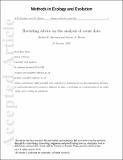Files in this item
Revisiting advice on the analysis of count data
Item metadata
| dc.contributor.author | Morrissey, Michael B. | |
| dc.contributor.author | Ruxton, Graeme D. | |
| dc.date.accessioned | 2021-07-25T23:35:25Z | |
| dc.date.available | 2021-07-25T23:35:25Z | |
| dc.date.issued | 2020-07-26 | |
| dc.identifier | 266484449 | |
| dc.identifier | 2eedcc20-a59a-4a10-bf95-f4d393c5fcf5 | |
| dc.identifier | 000552502800001 | |
| dc.identifier | 85088424515 | |
| dc.identifier.citation | Morrissey , M B & Ruxton , G D 2020 , ' Revisiting advice on the analysis of count data ' , Methods in Ecology and Evolution , vol. Early View . https://doi.org/10.1111/2041-210X.13372 | en |
| dc.identifier.issn | 2041-210X | |
| dc.identifier.other | RIS: urn:A141FF465061C158918A5D3B69977FD1 | |
| dc.identifier.other | ORCID: /0000-0001-8943-6609/work/78205024 | |
| dc.identifier.uri | https://hdl.handle.net/10023/23622 | |
| dc.description | Funding: MBM is supported by a University Research Fellowship from the Royal Society (London). | en |
| dc.description.abstract | 1. O’Hara and Kotze (2010; Methods in Ecology and Evolution 1: 118‐122) present simulation results that appear to show very poor behaviour (as judged by bias and overall accuracy) of linear models (LMs) applied to count data, especially in relation to generalised linear model (GLM) analysis. 2. We considered O’Hara and Kotze’s (2010) comparisons, and determined that the finding occurred primarily because the quantity that they estimated in their simulations of the LM analysis (the mean of a transformation of the count data) was not the same quantity that was simulated and to which the results were compared (the logarithm of the mean of the count data). We correct this discrepancy, re‐run O’Hara and Kotze’s simulations, and add additional simple analyses. 3. We found that the apparent superiority of the GLMs over LMs in O’Hara and Kotze’s (2010) simulations was primarily an artefact of divergence in the meanings of results from the two analyses. After converting results from LM analyses of transformed data to estimators of the same quantity as provided by the GLM, results from both analyses rarely differed substantially. Furthermore, under the circumstances considered by O’Hara and Kotze, we find that an even simpler implementation of LM analysis, inference of the mean of the raw data, performs even better, and gives identical results to the GLM. 4. While the analysis of count data with generalised linear models can certainly provide many benefits, we strongly caution against interpreting O’Hara and Kotze’s (2010) results as evidence that simpler approaches are severely flawed. | |
| dc.format.extent | 8 | |
| dc.format.extent | 647983 | |
| dc.language.iso | eng | |
| dc.relation.ispartof | Methods in Ecology and Evolution | en |
| dc.subject | Bias | en |
| dc.subject | Generalised linear model | en |
| dc.subject | Linear models | en |
| dc.subject | Ordinary least squares | en |
| dc.subject | Precision | en |
| dc.subject | Standard errors | en |
| dc.subject | Statistics | en |
| dc.subject | Transformation | en |
| dc.subject | QA Mathematics | en |
| dc.subject | QH301 Biology | en |
| dc.subject | DAS | en |
| dc.subject.lcc | QA | en |
| dc.subject.lcc | QH301 | en |
| dc.title | Revisiting advice on the analysis of count data | en |
| dc.type | Journal article | en |
| dc.contributor.sponsor | The Royal Society | en |
| dc.contributor.institution | University of St Andrews. School of Biology | en |
| dc.contributor.institution | University of St Andrews. Centre for Biological Diversity | en |
| dc.identifier.doi | 10.1111/2041-210X.13372 | |
| dc.description.status | Peer reviewed | en |
| dc.date.embargoedUntil | 2021-07-26 | |
| dc.identifier.grantnumber | URF/R/191012 | en |
This item appears in the following Collection(s)
Items in the St Andrews Research Repository are protected by copyright, with all rights reserved, unless otherwise indicated.

